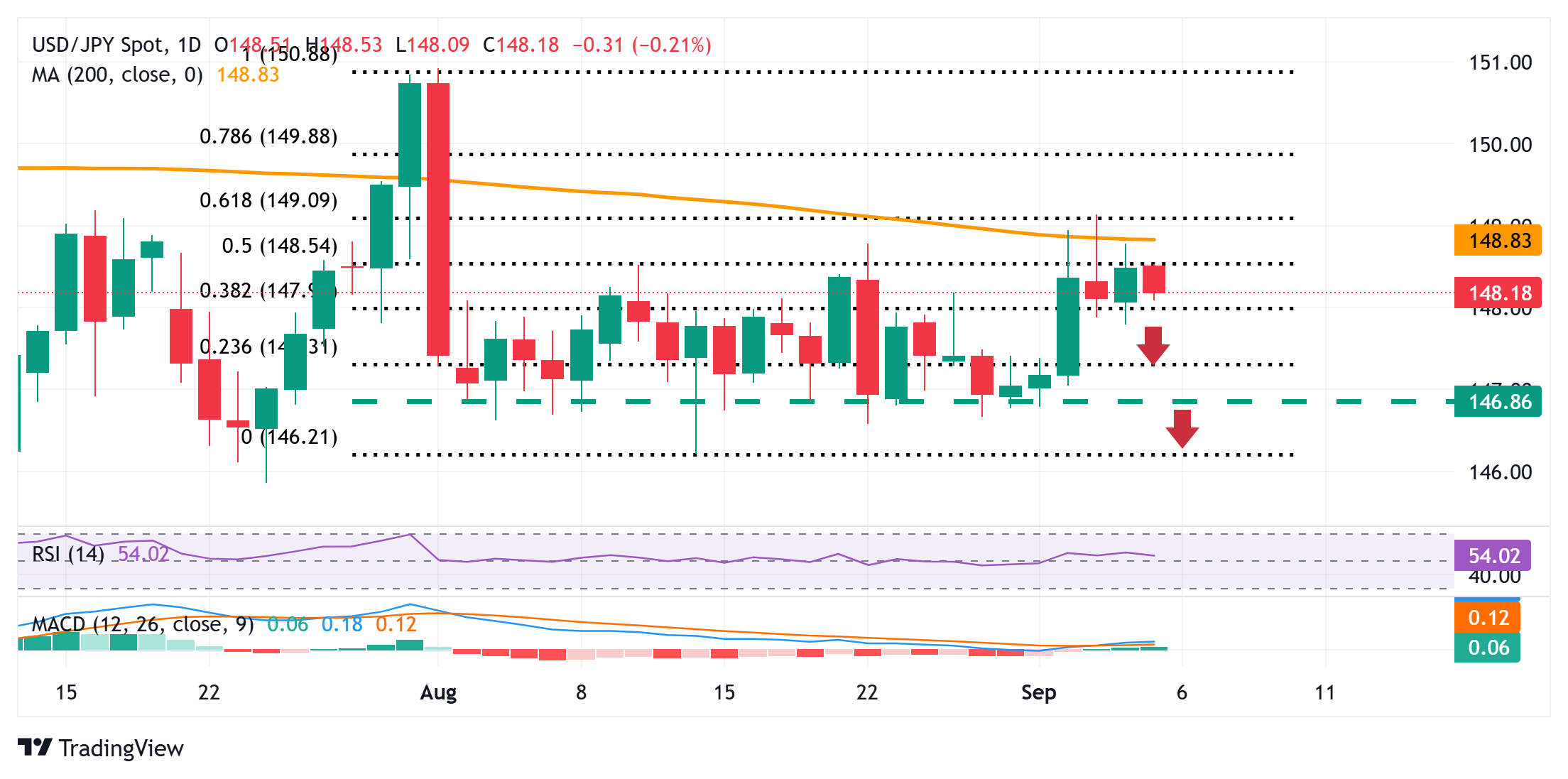Japanese Yen sticks to strong domestic data-led gains against a broadly weaker USD
- The Japanese Yen regains positive traction on Friday in reaction to upbeat domestic data.
- Furthermore, trade optimism overshadows the risk-on mood and further supports the JPY.
- Fed rate cut bets undermine the USD and also weigh on USD/JPY ahead of the US NFP report.
The Japanese Yen (JPY) remains on the front foot against a broadly weaker US Dollar (USD) amid firming expectations that the Bank of Japan (BoJ) will stick to its policy normalization path. The bets were reaffirmed by upbeat domestic data, which showed that real wages in Japan turned positive for the first time in seven months. Moreover, a rise in Japan’s household spending in July, although at a slower-than-expected pace, backs the case for an imminent BoJ rate hike by the year-end.
This comes after US President Donald Trump signed an executive order on Thursday to lower Japanese auto import tariffs and provide a modest lift to the JPY. However, a generally positive tone around the equity markets and political uncertainty in Japan could act as headwind for the safe-haven JPY. Furthermore, traders opt to wait for the release of the US Nonfarm Payrolls (NFP) report later during the North American session before placing fresh directional bets around the USD/JPY pair.
Japanese Yen retains positive bias as firming BoJ rate hike bets offset political uncertainty
- Data published by the Labour Ministry earlier this Friday showed that Japan’s nominal wages rose 4.1% year-on-year in July 2025, the fastest pace in seven months and above expectations for a 3% increase. Moreover, inflation-adjusted real wages, a key gauge of household purchasing power, turned positive for the first time since December and climbed 0.5% in July.
- Meanwhile, the consumer inflation rate the ministry uses to calculate real wages, which includes fresh food prices but not rent costs, rose 3.6% year-on-year in July. This was the slowest pace since November last year, though it far exceeded the Bank of Japan’s 2% inflation target and reaffirmed market bets for an imminent interest rate hike by the end of this year.
- A separate government report showed that Japan’s household spending in July rose 1.4% from a year earlier, falling short of the median market forecast for a 2.3% rise. On a seasonally adjusted, month-on-month basis, spending increased 1.7%, versus an estimated 1.3% rise. Adding to this, the trade optimism provides a modest lift to the Japanese Yen during the Asian session.
- US President Donald Trump signed an executive order on Thursday formalizing the lower tariffs on Japanese automobile imports, from the current 27.5% to 15%, and other products that were announced in July. The changes will take effect in seven days of being published in the Federal Register and removes a major uncertainty, which, in turn, boosts investors’ confidence.
- The US Dollar continues with its struggle to attract any meaningful buyers amid the growing acceptance that the US Federal Reserve will lower borrowing costs later this month. Moreover, traders are pricing in a greater chance of at least two 25-basis-point rate cuts by the end of this year. This turns out to be another factor exerting pressure on the USD/JPY pair.
- Investors now look forward to the release of the closely-watched US monthly employment details, due later during the North American session. The popularly known Nonfarm Payrolls report will play a key role in influencing expectations about the Fed’s rate-cut path, which, in turn, will drive the USD and determine the near-term trajectory for the USD/JPY pair.
USD/JPY bears need to wait for sustained break and acceptance below the 148.00 handle

From a technical perspective, the back to back failures near the 200-day Simple Moving Average (SMA) over the past two days and the subsequent slide favor the USD/JPY bears. However, slightly positive oscillators on the daily chart make it prudent to wait for some follow-through selling and acceptance below the 148.00 mark before positioning for further losses. Spot prices might then accelerate the fall to the 147.40 intermediate support en route to the 147.00 mark and the 146.70 horizontal zone. A convincing break below the latter would expose the August swing low, around the 146.20 region, before spot prices eventually drop to the 146.00 mark.
On the flip side, the 200-day SMA, currently pegged near the 148.75-148.80 region, might continue to act as an immediate hurdle ahead of the 1.4900 mark and the 149.20 area, or a one-month high touched earlier this week. The latter represents the 61.8% Fibonacci retracement level of the downfall from the August monthly swing high, which, if cleared decisively, would shift the bias in favor of bullish traders. The USD/JPY pair might then aim to reclaim the 150.00 psychological mark and extend the momentum further towards challenging the August monthly swing high, around the 151.00 neighborhood.




